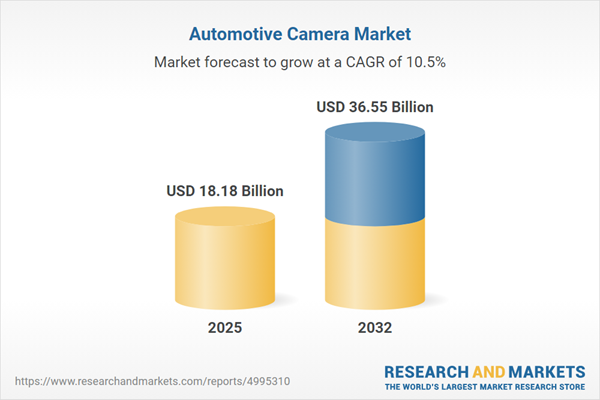Speak directly to the analyst to clarify any post sales queries you may have.
Automotive camera technology remains a vital driver for senior leaders managing digital transformation and compliance across vehicle fleets. As organizations face rapid shifts in safety demands and regulatory priorities, this market’s evolution directly impacts strategic planning and operational outcomes.
Market Snapshot: Automotive Camera Market Size and Growth
The automotive camera market is experiencing significant growth, fueled by increased deployment of advanced driver assistance systems (ADAS) and the expanding use of multi-camera setups. Original equipment manufacturers and technology partners are advancing imaging capabilities to keep pace with compliance and modernization demands. Evolving approval cycles and procurement strategies are transforming organizational approaches to camera system upgrades, ensuring operational efficiency while maintaining alignment with changing industry standards. For decision-makers, closely tracking these market shifts is integral to managing transitions as regulatory oversight and digital transformation accelerate.
Scope & Segmentation of the Automotive Camera Market
- Camera Types: Cabin, front, rear, side, and surround view cameras are integrated for fleet tracking, enhanced driver awareness, and regulatory compliance in commercial and passenger vehicles.
- Technology: CCD and CMOS sensors deliver robust imaging reliability suited for integration with ADAS and various operational environments.
- Resolution: Solutions span from standard HD to 4K, enabling both urban fleet monitoring and specialized, high-clarity surveillance needs.
- Applications: Parking management, security, asset analytics, and advanced tracking systems support more efficient and intelligent fleet operations.
- Vehicle Type: Camera platforms serve both passenger and commercial vehicles, ensuring operational and regulatory requirements are met within each segment.
- Sales Channel: Options include factory-fitted OEM installations and aftermarket upgrades, giving organizations flexible paths to support new and legacy vehicle fleets.
- Regional Coverage: North America, Europe, Asia-Pacific, and Middle East & Africa each present distinct sourcing and compliance challenges that impact market strategies and deployments.
- Leading Companies: Key providers such as Gentex Corporation, Hitachi Ltd., Kyocera Corporation, LG Electronics Inc., Magna International Inc., Continental AG, Denso Corporation, Panasonic Corporation, Robert Bosch GmbH, Valeo SA, Veoneer HoldCo LLC, and ZF Friedrichshafen AG continue to drive industry innovation and the evolution of standards.
Key Takeaways for Senior Automotive Decision-Makers
- Implementing advanced camera systems supports organizational efforts in safety, compliance, and flexible adaptation across mixed fleets.
- Integrated imaging with sensor platforms enhances automation and improves visibility, which is crucial for logistics, security, and fleet adaptability.
- Strategic partnerships with leading suppliers streamline adoption of emerging technologies and support navigation of updated regulatory demands.
- Configurable system architectures offer future-ready upgrade paths that minimize disruption while supporting initiatives in electrification and new mobility offerings.
- Aftermarket solutions allow legacy vehicles to remain compliant and valuable, maximizing fleet longevity as standards evolve.
- Procurement strategies tailored to local markets enable compliance and flexibility as regional regulations and technologies progress.
Tariff Impact
Forthcoming changes to United States tariff policy in 2025 are already impacting procurement for automotive camera systems. Organizations are adapting by diversifying supply chains, increasing production partnerships in Southeast Asia, and engaging more domestic suppliers. These shifts are designed to stabilize inventory management and reduce the risk associated with global trade disruptions, keeping project timelines and deployment schedules on course.
Methodology & Data Sources
Market research findings are based on comprehensive secondary data analysis and structured interviews with technical and industry experts. Insights are validated through patent review and structured data triangulation, providing decision-makers with substantiated, forward-looking intelligence for procurement and fleet planning.
Why This Automotive Camera Market Report Matters
- Clarifies the regulatory and technology trends that shape strategic direction for senior leadership during industry transformation.
- Enables actionable decisions regarding supplier choice, system architecture, and flexible operations aligned with current and future mobility requirements.
- Improves organizational resilience by supporting adaptive supply chain and fleet management strategies as the mobility sector evolves.
Conclusion
Keeping pace with automotive camera technology developments empowers organizations to pursue innovation, achieve compliance, and navigate ongoing changes in an evolving mobility landscape.
Additional Product Information:
- Purchase of this report includes 1 year online access with quarterly updates.
- This report can be updated on request. Please contact our Customer Experience team using the Ask a Question widget on our website.
Table of Contents
3. Executive Summary
4. Market Overview
7. Cumulative Impact of Artificial Intelligence 2025
Companies Mentioned
The companies profiled in this Automotive Camera market report include:- Gentex Corporation
- Hitachi, Ltd.
- Kyocera Corporation
- LG Electronics Inc.
- Magna International Inc.
- Continental AG
- Denso Corporation
- Panasonic Corporation
- Robert Bosch GmbH
- Valeo SA
- Veoneer HoldCo, LLC
- ZF Friedrichshafen AG
Table Information
| Report Attribute | Details |
|---|---|
| No. of Pages | 180 |
| Published | October 2025 |
| Forecast Period | 2025 - 2032 |
| Estimated Market Value ( USD | $ 18.18 Billion |
| Forecasted Market Value ( USD | $ 36.55 Billion |
| Compound Annual Growth Rate | 10.5% |
| Regions Covered | Global |
| No. of Companies Mentioned | 13 |









